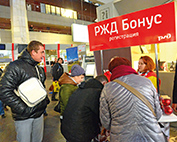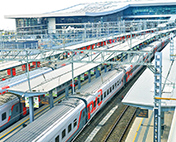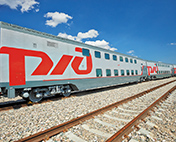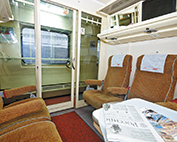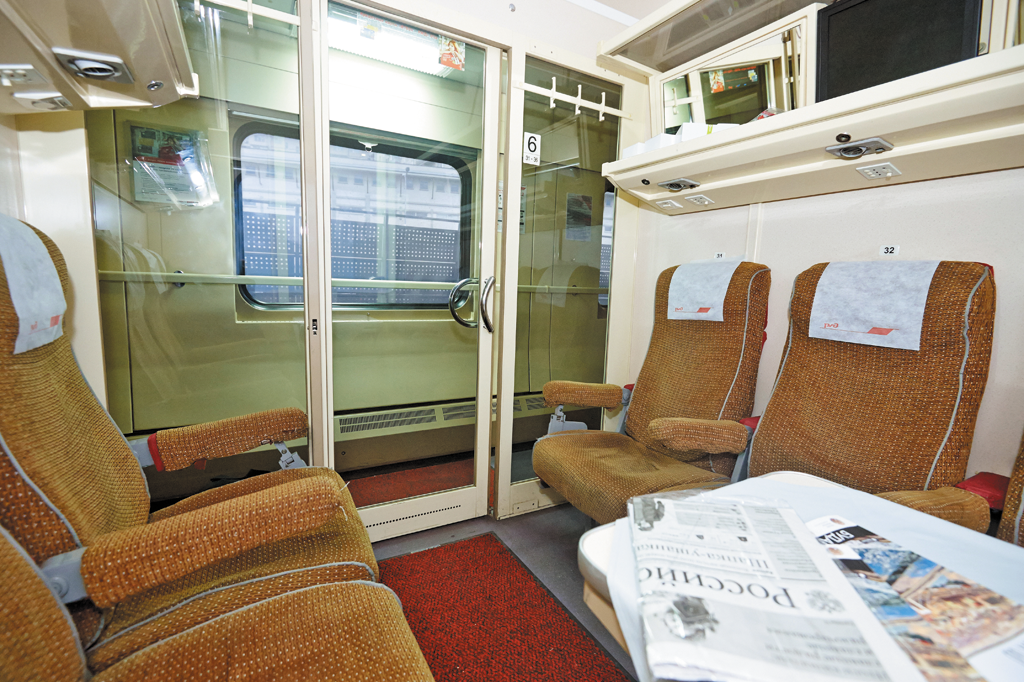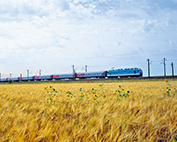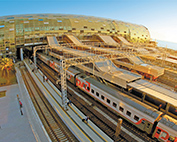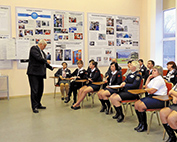A review of luxury rail car services
Food services on long-distance trains, in addition to the dining cars, were primarily provided in the luxury-class rail carriages, until March 2013.
As of March 1 2013, several JSC FPC trains that had previously included luxury-class rail carriages, were incorporated into the scope of the revenue management system.
On these trains, food provision in all the carriages was included in the cost of the train fare. As a result, the number of luxury-class carriages decreased by 21% — from 576 to 455.
The number of JSC FPC company trains with food services currently in the dynamic pricing system has increased to 20, and the average number of food portions stands at 8,000 a day on average.
Should there be particular demand for the provision of this type of support service, the company is proposing not to use luxury-class rail carriages.
In future, JSC FPC plans to automate the process of food selection on the JSC Russian Railways website, when passengers purchase their tickets.
Additional JSC FPC trains
JSC FPC branded trains account for 17% of the total number of trains in the 2013/2014 schedule. In 2013, 11 further train-pairs were certified into the ‘company’ branded category.
In 2013, 21.9 million passengers travelled using JSC FPC branded trains, a figure of 97% against the previous year; use of capacity was down 4.2% against the previous year’s figure at 68.4%, and income from travel services increased by 5% on the previous year’s figure to RUB 43,408.3 million.
All newly acquired train carriages have now been incorporated into JSC FPC branded trains.
November 1st 2013 saw the maiden departure of the first Duplex double-decker train Moscow — Adler. During the reporting year, 50 double-decker carriages were acquired for this (3 trains of 15 carriages, 5 carriages as reserve).
During Q4 2013 train services carried 94,612 passengers, 44% more than the figure for the same period in 2012, when the train consisted of single-storey carriages. The average distance travelled was 1,022 km. Use of train capacity amounted to 53% with a train of 12 carriages, on average, (1 sleeper carriage and 11 compartment-type carriages) and a seating capacity of 6,952. The profit from running this train service amounted to RUB 9.9 million, a profitability figure of 7%.
Under JSC FPC’s investment budget, it is planned to acquire a further 65 double-decker carriages.
Using trains consisting of double-decker carriages will enable the number of train-pair carriages to be reduced twofold, releasing one route ‘window’ in each direction, which can then be used only during periods of increased passenger traffic.
This line-up of double-decker carriages will be expanded in the future to include double-decker seated carriages and double-decker vehicle transportation carriages.
The company is reviewing the following routes on which to operate double-decker train carriages:
- Moscow — St. Petersburg;
- Moscow — Kazan;
- Moscow — Novorossiysk;
- Moscow — Kislovodsk;
- St. Petersburg — Kislovodsk;
- Nizhny Novgorod — Adler;
- Kislovodsk — Nizhny Novgorod;
- Moscow — Samara;
- Moscow — Penza.
Replacement of second-class sleeper carriages with seated carriages on short-haul routes
In the future, the company proposes to use seated carriages on those routes with a journey time of less than 6 hours and which operate during the day.
Seated carriages and multiple-unit trains have greater capacity and are cheaper to run (do not necessarily require a conductor, no bedding etc).
At the moment, however, the use of second-class sleeper carriages on short-haul daytime routes (less than 6 hours journey time) is economically justified, based on existing tariff policy.
Replacing second-class sleeper carriages for seated carriages will be feasible as the company’s rail fleet is updated and renewed and a sufficient number of seated carriages have been acquired.
A pre-requisite for the successful implementation of this project is to continue to work on developing the use of daytime trains on short-haul routes. In addition to rescheduling the operation of trains onto a day-based timetable and replacing the current rolling stock with seated carriages, the company is implementing measures to increase both the speed and the frequency of train services.
During the reporting year, the implementation of these measures company-wide showed significant results in the development of the train services segment operating on short-haul routes during the day. On train № 5/6 Petrozavodsk — St. Petersburg, for example, passenger throughput increased four-fold and on train № 153/154 Nizhny Novgorod — Moscow, passenger throughput was up 1.6 times.
In the 2014/2015 schedule the company plans to:
- Expand the conversion of accelerated daytime trains on the following routes: Nizhny Novgorod — Kirov, Kazan — Izhevsk, Krasnodar —Adler and Rostov — Krasnodar;
- Increase the number of daytime train-pairs on existing routes: Moscow — Bryansk, Moscow — Voronezh and Moscow — Nizhny Novgorod;
- Acquire 2 trains of 33 carriages with a centralised power supply for some of the routes listed above;
- Lease Lastochka (Desiro) rolling stock which was used on daytime routes during the period of organising the transport of guests and participants of the Sochi 2014 Olympics.
Improving sales, branding and advertising channels
The objective of this project is to actively develop electronic sales and passenger information channels and to increase ticket sales.
The share of e-ticket sales for long-distance train services in 2013 increased by 6 p.p. against the figure for the previous year to 19% (over 22.6 million seats); this includes sales using the self-service transaction terminals through which over 1.5 million seats were sold 39% higher than the figure for 2012 (1.07 million seats).
In 2013, the following promotions were introduced to increase electronic sales and service channels:
- As of 24 January 2013, a smartphone app was released with iOS and Android operating systems, enabling rail tickets to be purchased over the Internet;
- In May 2013, the portal for purchasing e-tickets on the www.rzd.ru. was fully revamped to make it more user-friendly. An English version of the service was also launched;
- As of 1st December 2013, an e-registration service was launched on all JSC FPC routes and trains (registration to be completed 1 hour before the train leaves at the station of departure);
- As of 4 June 2013, an e-registration service was introduced on train services with Ukraine on train № 1/2 Moscow — Kiev and № 29/30 Moscow — Simferopol;
- As of 1st July 2013, an e-registration service was introduced on train № 69/70 Saratov — Berlin (including the non-stop services from St. Petersburg — Berlin, Novosibirsk — Berlin, Adler — Berlin and Chelyabinsk — Berlin);
- As of October 2013, an e-registration service on trains № 17/18 Moscow — Nice and № 23/24 Moscow — Berlin — Paris is being made available to passengers at any point along the entire route before the train leaves the station where the passenger boarded the train.
In addition to developing e-sales, the company is actively encouraging the public to purchase tickets through electronic sales channels:
- Marketing promotions were run on the www.rzd.ru website and via the JSC FPC self-service transaction terminals throughout 2013, providing discounts on tickets purchased using electronic sales channels for long-distance train services;
- The company conducted a specialised advertising campaign, encouraging the purchase of tickets in addition to just at railway ticket offices. As of June 2013 a QR-code is being displayed on all advertising and ticket slips, thereby allowing customers to transfer quickly to the site;
- In September 2013, on the www.rzd.ru website and in stations in Moscow, an informative video-clip was displayed that provided a brief description of the main elements of how to register, pay for and return tickets as well as e-registration guidelines;
- In November 2013, a major federal advertising campaign was conducted in conjunction with the company MasterCard to promote e-ticket sales.
The intensive development of sales via bank card payments was facilitated by allocating a substantial Visa and MasterCard payments system under a separate ‘Rail Services’ category.





